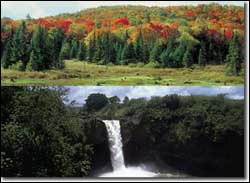Models show growing more forests in temperate regions could contribute to global warming

New climate modeling research from LLNL and the Carnegie Institution shows that northern temperate forests (top) may contribute to global warming, while tropical forests (bottom) can help keep global temperatures cool.
Planting trees across the United States and Europe to absorb some of the carbon dioxide emitted by the burning of fossil fuels may just outweigh the positive effects of sequestering that CO².
New climate modeling research from LLNL and the Carnegie Institution shows that northern temperate forests (top) may contribute to global warming, while tropical forests (bottom) can help keep global temperatures cool. (Click here to download a high-resolution image.)
In theory, growing a forest may sound like a good idea to fight global warming, but in temperate regions, such as the United States, those trees also would soak up sunlight, causing the earth’s surface to warm regionally by up to 8 degrees Fahrenheit.
Forests affect climate in three different ways: they absorb the greenhouse gas, carbon dioxide, and help to keep the planet cool; they evaporate water to the atmosphere, which also helps keep the planet cool; and they are dark and absorb a lot of sunlight, warming the Earth.
Using climate models, researchers from Lawrence Livermore National Laboratory and the Carnegie Institution Department of Global Ecology have found that forests in the mid-latitude regions of the Earth present a more complicated picture. Trees in these areas tend to warm the Earth in the long run.
The darkness of these forests absorbs abundant sunlight, warming the land. While the darkness of the forest lasts forever, the effect of the forest sequestering carbon dioxide slows down over time as the atmosphere exchanges CO² with the ocean.
The conclusion: Planting a forest in the United States could cool the Earth for a few decades, but would lead to planetary warming in the long term. These are the results of a study that will be presented at 8:30 a.m. Wednesday, Dec. 7, at the American Geophysical Union Fall Meeting in San Francisco.
“On time scales longer than a few centuries, the net effect will actually be warming in these regions,” said Govindasamy Bala of the Livermore team. “We thought planting trees across the northern hemisphere would help curb global warming by the CO² absorption but what we found was a different story.”
The authors discovered that a global replacement of current vegetation by trees would lead to a global warming of 2.4 degrees Fahrenheit. Global replacement with grassland led to cooling of about 0.7°F.
The researchers also found that planting trees between 30 and 50 degrees latitude worldwide saw the global mean surface air temperature increase by 0.7°F. Regional warming in North America and Eurasia was as high as 8°F. In earlier studies, planting trees in the boreal forest regions (found mostly in the upper half of the Northern Hemisphere) caused a warming of surface temperatures.
“Although it was previously known that trees could have an overall warming effect in the boreal forests (north of 50 degrees), this is the first study to show that temperate forests could lead to net global warming,” said Livermore’s Seran Gibbard, lead author of the study.
The story is different for the tropical forests. In tropical regions, forests help keep the Earth cool by not only absorbing carbon dioxide, but by evaporating plenty of water as well.
“Should we give carbon credit to the planting of forests? Probably not for countries in mid and high latitudes,” Bala said. “But the tropical forests present a win-win because they cool the planet by evaporative cooling and the uptake of carbon.”
Co-author Ken Caldeira of the Carnegie Institution warned that proposals to grow more forests to cool the planet should be greeted with caution.
“I like forests. They provide good habitats for plants and animals, and tropical forest are good for climate, so we should be particularly careful to preserve them,” he said. “But in terms of climate change, we should focus our efforts on things that can really make a difference, like energy efficiency and developing new sources of clean energy.”
The research, also authored by Thomas Phillips and Michael Wickett of Lawrence Livermore, will appear online in the Dec. 8 issue of the journal Geophysical Research Letters.
Founded in 1952, Lawrence Livermore National Laboratory has a mission to ensure national security and apply science and technology to the important issues of our time. Lawrence Livermore National Laboratory is managed by the University of California for the U.S. Department of Energy’s National Nuclear Security Administration.
Media Contact
More Information:
http://www.llnl.govAll latest news from the category: Earth Sciences
Earth Sciences (also referred to as Geosciences), which deals with basic issues surrounding our planet, plays a vital role in the area of energy and raw materials supply.
Earth Sciences comprises subjects such as geology, geography, geological informatics, paleontology, mineralogy, petrography, crystallography, geophysics, geodesy, glaciology, cartography, photogrammetry, meteorology and seismology, early-warning systems, earthquake research and polar research.
Newest articles

How marine worms regenerate lost body parts
The return of cells to a stem cell-like state as the key to regeneration. Many living organisms are able to regenerate damaged or lost tissue, but why some are particularly…

Nano-scale molecular detective
New on-chip device uses exotic light rays in 2D material to detect molecules. Researchers have developed a highly sensitive detector for identifying molecules via their infrared vibrational “fingerprint”. Published in Nature…

Novel CAR T-cell therapy
… demonstrates efficacy and safety in preclinical models of HER2-positive solid tumors. The p95HER2 protein is found expressed in one third of HER2+ tumors, which represent 4% of all tumors….



